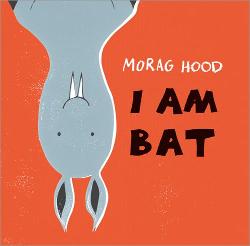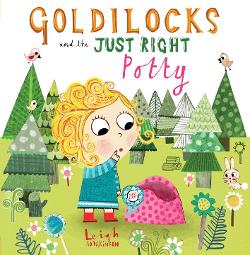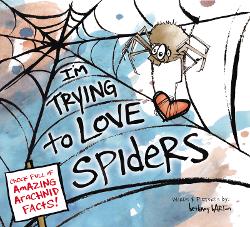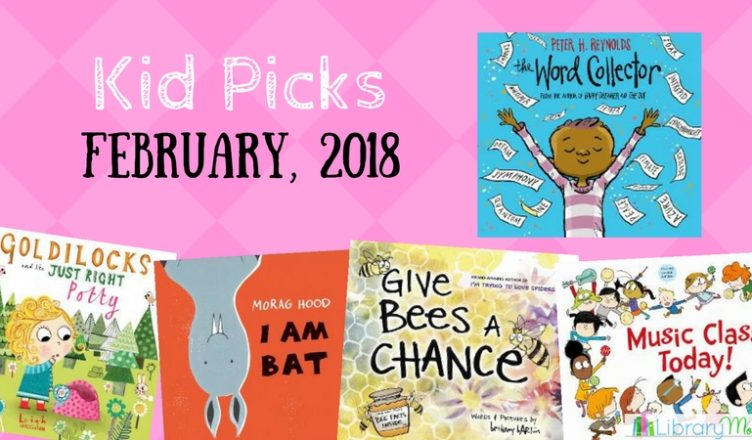This month we had fun learning about bees, celebrating the power of words, giggling at a silly bat, learning some potty training tips, and singing about music class. What a month filled with some wonderful books!
 I Am Bat by Morag Hood, 2017
I Am Bat by Morag Hood, 2017
(Ages 2 – 6)
A possessive fruit bat informs readers of his love for his favorite snack, cherries. He loves them so much, in fact, that he is not willing to share. He warns readers not to touch his cherries or he will become very angry. Suddenly, a little paw peeks out from the top of the page and nabs one of the cherries. When Bat notices they are missing, he addresses the reader, “Who stole my cherries? Was it you?” In the background, children will notice even more animal friends slyly removing the cherries. A distraught Bat slumps down declaring, “I will never be happy again.” Overhead, his friends peek in and deliver a pear. In a satisfying ending, bat becomes elated by his new snack, but now warns readers not to touch his pear.
I have to admit that I thought this book was just okay the first time we read it, but both my two-year-old daughter and five-year-old son asked for repeated readings day after day, so there is clearly kid appeal. They found Bat to be hilarious and loved interacting with the book when Bat addresses the reader. The seemingly simple illustrations perfectly capture Bat’s range of emotions and the bright background colors are playful and engaging. Not only is this book quirky and funny, it could also prompt a conversation about sharing and trying new foods.
 Goldilocks and the Just Right Potty by Leigh Hodgkinson; published by Nosy Crow, 2017
Goldilocks and the Just Right Potty by Leigh Hodgkinson; published by Nosy Crow, 2017
(Ages 2 – 4)
In this clever fractured fairytale, Goldilocks is a toddler who is ready to put her soggy diapers behind her and graduate to big-girl underwear. After finding her just-right undies, and a just-right potty, Goldilocks works on figuring out the just-right time to go to the bathroom. Sometimes she thinks she needs to pee, but then realizes she doesn’t have to after all. Sometimes she doesn’t need to, but then has an accident. Goldilocks never gives up though, and in a scene filled with rainbows and shouts of “Yahoo” and “Yippee” the reader sees that Goldilocks finally gets it just right.
My two-and-a-half-year-old is just starting to potty train and when we brought home a pile of books, she immediately gravitated toward this one. My daughter is so excited for her own big-girl undies and loved watching Goldilocks pick out her own. I think it was also good for her to see another child figuring out the potty training process at the same time. Goldilocks didn’t get it right away; she made mistakes and had accidents and that was okay. Potty training takes time and persistence. She finally got it in the end and I know my daughter will too.
In addition to the great lesson on potty training, this book is a standout due to its illustrations. I absolutely love Leigh Hodgkinson’s mixed-media artwork and the addition of different font types adds to the playfulness of the book. Those children familiar with the fairytale will notice several nods to the original, such as the family eating porridge and Goldilocks playing with three little bear dolls. This book is age-appropriate, engaging, and just-right for potty training.
 Music Class Today! by David Weinstone; illustrated by Vin Vogel, 2015
Music Class Today! by David Weinstone; illustrated by Vin Vogel, 2015
(Ages 2 – 5)
Whether through storytime at the library or a private class, many children attend some type of musical program during their early years. This book is the perfect story to prepare them for such a class. A guitar playing teacher welcomes a diverse group of children with a song. The reader is encouraged to sing the text highlighting each stage of the class from playing with egg shakers, sticks, and scarves to dancing and exploring a range of instruments.
Several of the details in the illustrations can prompt a discussion on safe behavior during a musical program. While many of the drawings demonstrate children acting correctly with the instruments, a few exhibit inappropriate behavior. For example, one picture shows a girl running around with sticks on her head with the word “danger” surrounding her.
Another important message is that children don’t have to jump in if they don’t want to. One child shyly hides on his mother’s lap during the songs and is never pressured to join. He is reassured with the words, “That’s all right, that’s okay. Whenever you’re ready, come over and play. That’s all right, there’s no rush. Whenever you’re ready come play with us!” The positive messaging along with the sing-song text and comical, cartoonish illustrations makes this a great book to share one-on-one or with a group.
My two-year-old daughter just loved this book and asked for it several days in a row. She currently attends a music class and really enjoyed reading a book about one of her favorite weekly activities. Even though I can’t carry a tune, I still enjoyed singing the catchy lines of this entertaining book.
 The Word Collector by Peter H. Reynolds, 2018
The Word Collector by Peter H. Reynolds, 2018
(Ages 4 – 8)
I don’t know how Peter Reynolds can continue to create so many amazing and inspiring books, but MAN he is good! The Word Collector is his latest accomplishment. While many children may collect a variety of things, Jerome collects words. Words are all around us, and Jerome carefully jots down his favorites. After an accident, Jerome’s words become jumbled. He finds that when he combines his words, they make the most incredible poems and songs. He further discovers that by knowing more words, he can better articulate his thoughts and feelings with others. In an unselfish act, he decides to scatter his collection of words in the wind in order to share all of his literary treasures with other children. The book ends with the challenge, “Reach for your own words tell the world who you are and how you will make it better.” My five-year-old loved reading about Jerome and his amazing collection and can’t wait to start writing down his own favorite words!
 Give Bees a Chance by Bethany Barton, 2017
Give Bees a Chance by Bethany Barton, 2017
(Ages 4 – 10)
Bethany Barton has discovered the perfect mix of information, humor, and clever illustrations to bring nonfiction books alive to children. Give Bees a Chance skillfully presents interesting facts about bees with a comical dialogue between an unseen narrator and his friend, Edgar, who is terrified of bees. The narrator deflects Edgar’s arguments against bees with fascinating tidbits about a bee’s anatomy, history, ability to make honey, and impact on the environment. The amusing illustrations accentuate the data on bees and add to the drollness of the story.
Like Edgar, my five-year-old son is afraid of bees. After reading this book, however, he has a new appreciation for them and even suggested we plant some bee-friendly flowers to help the bee population. He added that he would like to plant them at his grandparents’ house in Florida, thousands of miles away, but at least it is a start! He requested that we read this book multiple times and loved soaking up new facts about bees. He also loved the interactive element of gently blowing the bees away from Edgar.
I’m Trying to Love Spiders (2015) was also a favorite of our family and at the elementary school where I used to teach. The engaging illustrations, amusing humor, and interactive directions make these books wonderful read alouds. They are perfect for kicking off a nonfiction unit in the classroom or reading one-on-one with a child.







